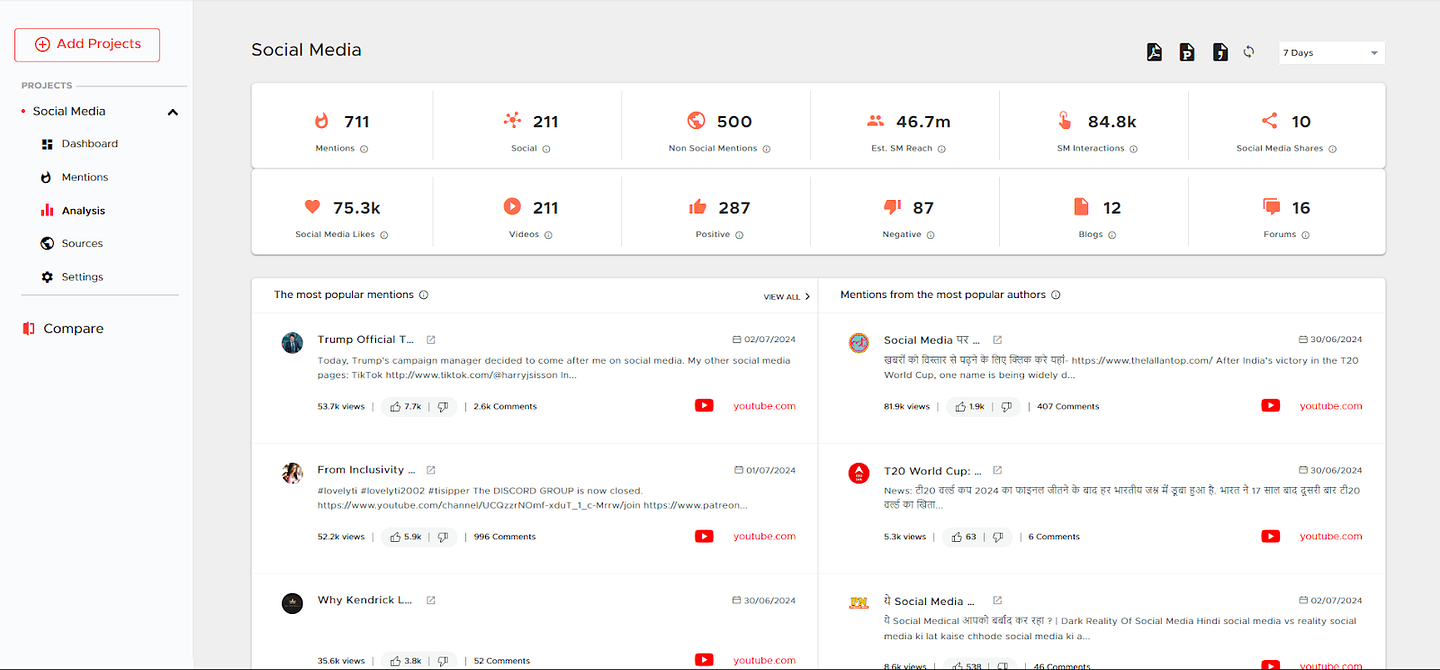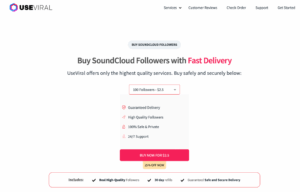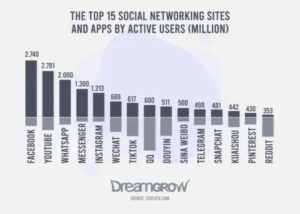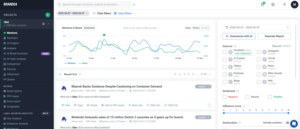Today, the sheer volume of online conversations presents a goldmine of information for businesses. Social listening, the process of monitoring and analyzing digital interactions, is crucial for brands that want to stay relevant and responsive. This comprehensive guide will delve into the complexity of social listening, its benefits, and how you can utilize it effectively in your business strategy.

Social listening involves more than just tracking mentions of your brand on social media. It encompasses monitoring discussions across various platforms — blogs, forums, news sites, and more — to gain a holistic understanding of what’s being said about your brand, your competitors, and your industry.
Key Components of Social Listening
Monitoring
Tracking Mentions: This involves setting up alerts and using tools to capture mentions of your brand, products, competitors, and relevant industry keywords across multiple platforms. This monitoring is not limited to social media; it extends to blogs, forums, review sites, and news outlets.
Listening to Conversations: It’s essential to understand the who, what, where, when, and why behind each mention. Who is talking about your brand? What are they saying? Where are these conversations happening? When are they occurring? And why are people discussing these topics? This deeper level of listening helps in comprehending the significance of public sentiment.
Analysis
Sentiment Analysis: Are the comments positive, negative, or neutral? Sentiment analysis helps in understanding the general mood of the public towards your brand. Advanced tools use natural language processing (NLP) to automatically gauge sentiment, providing insights that can help shape your marketing and customer service strategies.
Trend Identification: By continuously monitoring conversations, you can identify emerging trends in customer preferences, behaviors, and industry developments. This could involve spotting a new competitor gaining traction, a shift in consumer interests, or changes in how customers are using your products.
Competitor Analysis: By analyzing what’s being said about your competitors, you can gain insights into their strengths and weaknesses, customer perceptions, and potentially effective strategies they’re using.

Engagement
Responding to Feedback in real-time: Whether it’s thanking a customer for positive feedback or addressing a complaint, timely responses can significantly enhance customer satisfaction and loyalty.
Influencer Collaboration: Identifying key influencers in your industry through social listening can open up opportunities for collaboration. Engaging with influencers who have a substantial following can amplify your brand’s reach and credibility.
Community Building: Building a loyal online community involves actively participating in conversations, sharing valuable content, and fostering relationships with your audience. Social listening helps in identifying the right conversations to join and the type of content that resonates with your audience.
The Benefits of Social Listening
Enhanced Customer Service
Proactive Problem Solving: By identifying customer issues as soon as they arise, you can address them promptly, preventing potential crises. This proactive approach not only improves customer satisfaction but also demonstrates that you value customer feedback.
Personalized Interactions: Social listening provides insights into individual customer preferences and behaviors, allowing you to tailor your interactions and offers to meet their specific needs.
Crisis Management
Early Detection: Social listening enables you to detect potential issues early, giving you the opportunity to manage them before they escalate. This could involve identifying negative sentiment around a product launch or addressing a brewing PR crisis.
Strategic Response: By understanding the context and sentiment behind negative mentions, you can craft more effective responses that address the root cause of the issue, rather than just the symptoms.
Market Research
Consumer Insights: Social listening provides real-time insights into what your customers are talking about, what they like, and what they don’t. These insights are incredibly important for product development, marketing strategies, and overall business planning.
Competitive Intelligence: Keeping an eye on your competitors through social listening helps you understand their strategies, strengths, and weaknesses. This information can inform your own competitive strategies and highlight opportunities for differentiation.

Competitive Advantage
Stay Ahead of Trends: By identifying emerging trends early, you can adapt your strategies to stay ahead of the competition. This could involve launching new products that meet evolving customer needs or adopting new marketing tactics that resonate with your audience.
Benchmarking: Regularly analyzing competitors’ mentions and sentiment can provide benchmarks against which you can measure your own performance. This helps you set achievable goals and understand where you need to improve.
Brand Health Tracking
Reputation Management: Social listening helps you understand overall brand perception and track changes over time. This is crucial for managing your brand’s reputation and making informed decisions that enhance brand image.
Customer Loyalty: By consistently engaging with your audience and addressing their concerns, you can build stronger relationships and foster loyalty. Social listening helps in identifying the key factors that drive customer loyalty and satisfaction.
Tools for Social Listening
Hootsuite
Features: Hootsuite offers robust social media monitoring, scheduling, and analytics tools. It allows you to track mentions, keywords, and hashtags across multiple platforms, making it easier to stay on top of conversations about your brand.
Benefits: Hootsuite’s comprehensive analytics provide insights into engagement trends and audience demographics, helping you refine your social media strategies. Its scheduling feature also ensures that you can maintain a consistent online presence.
Brandwatch
Features: Brandwatch provides detailed insights and analytics on brand mentions and sentiment. It uses advanced algorithms to track conversations across various platforms and languages.
Benefits: Brandwatch’s customizable dashboards and in-depth reports make it easy to visualize data and identify actionable insights. Its integration capabilities with other tools also enhance its functionality, making it a powerful addition to your marketing toolkit.
Crowdfire
Features: Crowdfire offers social media management, content curation, and social listening tools. It helps you track mentions, monitor competitor activity, and engage with your audience.
Benefits: Crowdfire’s Web Listening feature provides valuable insights into audience preferences and industry trends. Its content curation feature is also particularly useful for maintaining a steady stream of engaging content.

Implementing Social Listening
Define Goals
Set Clear Objectives: Establishing clear objectives is crucial for effective social listening. Are you looking to improve customer service, track brand health, monitor competitors, or identify market trends? Defining your goals helps you select the right tools and metrics to track them.
Measure Success: Determine how you will measure success. This could involve tracking specific metrics such as the number of mentions, sentiment scores, or engagement rates. Regularly reviewing these metrics ensures that you stay on track and can adjust your strategies as needed.
Select Keywords
Identify Relevant Keywords: Choosing the right keywords and hashtags is essential for effective social listening. This includes not only your brand name and products but also industry-specific terms, competitor names, and common misspellings.
Expand Your List: Regularly update your keyword list to include new terms, trending topics, and seasonal keywords. This ensures that you capture a comprehensive range of conversations relevant to your brand and industry.
Analyze Data
Regular Review: Regularly analyze the collected data to extract meaningful insights. This involves not just looking at numbers but also understanding the context behind them. For instance, a spike in mentions could indicate a successful campaign or a brewing crisis.
Identify Patterns: Look for patterns and trends in the data. This could involve identifying common themes in customer feedback, tracking changes in sentiment over time, or spotting emerging trends in your industry.

Act on Insights
Inform Strategies: Use the insights gained from social listening to inform your marketing, product development, and customer service strategies. This could involve launching new products based on customer preferences, adjusting your marketing messages to better resonate with your audience, or improving your customer service processes.
Continuous Improvement: Social listening is an ongoing process. Regularly review and refine your strategies based on the insights you gain. This continuous improvement approach ensures that you stay responsive to customer needs and market changes.
Social listening is an invaluable tool for businesses looking to stay competitive in the digital age. By monitoring and analyzing online conversations, you can gain deep insights into customer preferences, market trends, and competitive dynamics. Implementing social listening effectively involves setting clear goals, selecting the right tools, and acting on the insights gained. By integrating social listening into your business strategy, you can enhance customer satisfaction, manage your brand’s reputation, and drive business growth.



